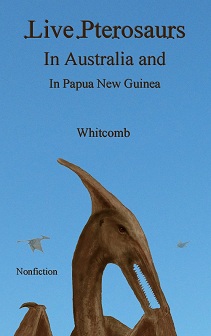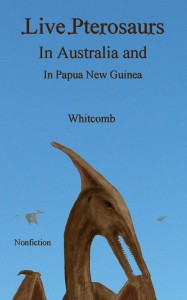I have neglected writing many blog posts, of necessity, over the past few days, for my newest nonfiction book needed much editing and formatting before being sent to Amazon. Live Pterosaurs in Australia and in Papua New Guinea will soon be available for purchase online, at least on the Amazon-Kindle store. Marketing will be focused on Australia, so the spelling (“metres,” for example) is adjusted for Down-Under. But Americans should have no trouble with this nonfiction cryptozoology ebook.
The Amazon processing normally takes at least twelve hours or so, making the earliest date for purchase around September 9, 2012. UPDATE: It was on Amazon, for a low price, but it is now FREE, as a simple pdf download. Get this as a giveaway: Live Pterosaurs in Australia and in Papua New Guinea. This should help people around the world to know about these extraordinary nocturnal flying creatures that are very much NON-extinct.
Promotional materials include the following (here quoted in part):
Featherless creatures fly overhead, in Papua New Guinea and in Australia. This nonfiction gives you up-to-date eyewitness reports, informing you why these creatures are still alive and why they are so rarely reported in newspapers.
Why do these large long-tailed flying creatures sometimes appear in daylight, when they are nocturnal? Why do natives in Papua New Guinea report their encounters but Australians rarely talk about them? Get the details from the world’s most prolific nonfiction author on this subject of modern living pterosaurs.
Update: My cryptozoology ebook is now available, for $3.99 (U.S. dollars) on Amazon, as a Kindle book: Live Pterosaurs in Australia and in Papua New Guinea. It has been submitted as a potential “Kindle Single.” Update: As of August 24, 2014, it is absolutely free, on the alivedragon site.
From the Introduction (excerpt):
We must begin with the basics: What is a pterosaur? It’s not really a type of dinosaur, although it’s associated with them. The flying creature is called “pterodactyl” by many non-scientists; some Americans call those featherless fliers “dinosaur birds” or “prehistoric birds.”
Most pterosaur fossils fit into one of two types: long-tailed Rhamphorhynchoid or shorter-tailed
Pterodactyloid. Those two types differ in other ways, not just tail length, but that’s a subject for a book
on pterosaur fossils.In modern eyewitness reports, long-tailed pterosaurs outnumber short-tails, at least four-to-one. Standard models of extinction make this ratio appear strange, for the long-tailed variety were thought to have dwindled before the short-tailed pterosaurs became dominant, at least that’s the theory. Nevertheless, the ratio is significant in modern sightings, appearing consistent regardless of the culture or beliefs or education of the eyewitness.
But most of the Australian sightings in the new book have never been published before in any book, and there are at least two new ropen sighting reports from Papua New Guinea.




